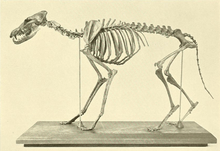Pleistocene coyote
The Pleistocene coyote (Canis latrans orcutti), also known as the Ice Age coyote, is an extinct subspecies of coyote that lived in western North America during the Late Pleistocene era. Most remains of the subspecies were found in southern California, though at least one was discovered in Idaho. It was part of a carnivore guild that included other canids like foxes, gray wolves, and dire wolves.[2]
| Pleistocene coyote | |
|---|---|
 | |
| Scientific classification | |
| Kingdom: | Animalia |
| Phylum: | Chordata |
| Class: | Mammalia |
| Order: | Carnivora |
| Family: | Canidae |
| Genus: | Canis |
| Species: | C. latrans |
| Subspecies: | C. l. orcutti |
| Trinomial name | |
| Canis latrans orcutti | |
Compared to their modern Holocene counterparts, Pleistocene coyotes were larger and more robust, weighing 39–46 lb (18–21 kg),[3] likely in response to larger competitors and prey rather than Bergmann's rule. Their skulls and jaws were significantly thicker and deeper than in modern coyotes, with a shorter and broader rostrum and wider carnassial (denoting the large upper premolar and lower molar teeth of a carnivore, adapted for shearing flesh) teeth. These adaptions allowed it to cope with higher levels of stress, when it killed larger prey, compared to modern coyotes.[2] Pleistocene coyotes were also likely more specialized carnivores than their descendants, as their teeth were more adapted to shearing meat, showing fewer grinding surfaces which were better suited for processing vegetation. The lower jaw was also deeper, and the molars showed more signs of wear and breakage than modern populations, thus indicating that the animals consumed more bone than today.[4] Behaviorally, it is likely to have been more social than the modern coyote, as its remains are the third most common in the La Brea Tar Pits, after dire wolves and sabre-toothed cats, both thought to be gregarious species.[2]
Their reduction in size occurred within 1,000 years of the occurrence of the Quaternary extinction event, when the climate changed and the majority of their larger prey became extinct.[2] Furthermore, Pleistocene coyotes were unable to successfully exploit the big game hunting niche left vacant after the extinction of the dire wolf, as that gap was rapidly filled by gray wolves. These gray wolves are likely to have actively killed off the larger-bodied coyotes, with natural selection favoring the modern gracile morph.[4] Human predation on the Pleistocene coyote's dwindling prey base may have also impacted the animal's change in morphology.[2]
Canis latrans harriscrooki
Canis latrans harriscrooki[5] (Slaughter, 1961)[6][7] is another extinct Late Pleistocene coyote that once inhabited what is now Texas. Slaughter described it as being wolf-like and was distinguished from other coyotes by a well-developed posterior cusp on its p2 (the second premolar on its mandible), a longer tooth row relative to the depth of its mandible, a reduced distance between premolars, and a more vertical descending ramus. The cusp dentition was also found in two specimens from Mexico and one from Honduras.[6] Slaughter identified some affinity with C. l. hondurensis.[8] Nowak proposed the hypothesis that a warm-adapted coyote that was more wolf-like than modern coyotes once inhabited Pleistocene Texas and might still be represented by C.l. hondurensis.[9]
Canis latrans riviveronis
Canis riviveronis (Hay, 1917)[10] is a coyote that once lived in Florida during the Pleistocene. The specimen is described as a coyote, but it being latrans was questionable. It differed from the extant coyote by having the anterior lobe of the carnassial relatively shorter, and the teeth broader. It was not a wolf nor an Indian dog.[10]
References
- Canis latrans Say 1823 (coyote) and synonyms Fossilworks database
- Meachen, J., Samuels, J. (2012). Evolution in coyotes (Canis latrans) in response to the megafaunal extinctions. PNAS : 10.1073/pnas.1113788109
- Choi, C. Q. (February 27, 2012). How Coyotes Dwindled to Their Modern Size. LiveScience
- Meachen JA, Janowicz AC, Avery JE, Sadleir RW (2014) Ecological Changes in Coyotes (Canis latrans) in Response to the Ice Age Megafaunal Extinctions. PLoS ONE 9(12): e116041. doi:10.1371/journal.pone.0116041
- Canis latrans harriscrooki, Shuler Museum of Paleontology, Southern Methodist University, Texas.
- Slaughter, B.H. (1961) A new coyote in the Late Pleistocene of Texas. Journal of Mammalogy 42(4):503–509.
- Slaughter, B.H., Crook, W.W., Jr., Harris, R.K., Allen, D.C., and Seifert, M. (1962) The Hill-Shuler local faunas of the Upper Trinity River, Dallas and Denton counties, Texas. Report of Investigations, University of Texas Bureau of Economic Geology 48: 1–75.
- Slaughter, Bob H. (1966). "Platygonus compressus and Associated Fauna from the Laubach Cave of Texas". American Midland Naturalist. 75 (2): 475–494. doi:10.2307/2423406. JSTOR 2423406.
- Nowak, R. M. (1979). North American Quaternary Canis. 6. Monograph of the Museum of Natural History, University of Kansas. p. 81. ISBN 978-0-89338-007-6.
- O. P. Hay. 1917. Vertebrata mostly from Stratum No. 3, at Vero, Florida, together with descriptions of new species. Florida State Geological Survey Annual Report 9:43-68